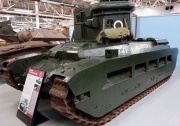Matilda Tank





Mark I
- Manufacturer: Vickers-Armstrongs
- Service: 1939-40
Mark II
- Manufacturer: Vulcan Foundry
- Engines: Two AEC 6-cylinder 13.3-litre 174-hp
- Service: 1940-45
The Tank, Infantry, Mk II, Matilda II (A12) (sometimes referred to as Senior Matilda) was a British tank of World War II. In a somewhat unorthodox move, it shared the same name as the Tank, Infantry, Mk I (A11). The name Matilda itself comes from a cartoon duck. Matilda is also an old Teutonic female name meaning "mighty battle maid".
When the A11 was removed from service the A12's name of Matilda II was dropped, and it was then known as just the Matilda.
The Tank, Infantry, Mk II was designed at the Royal Arsenal, Woolwich, and built by the Vulcan Foundry, as an improvement on the Mk I which was a two man tank with only machine guns for armament. The Senior Matilda weighed 27 metric tons, more than twice as much as its predecessor, and was armed with a QF 2-pounder tank gun in a three-man turret.
Like other infantry tanks it was heavily armoured; from 20 mm at the thinnest it was 78 mm (3.1 inch) at the front, much more than most contemporaries. The weight of the armour, together with the relatively weak twin-engine power unit (adapted from a bus) and troublesome suspension severely limited the speed of the vehicle. For example, in the deserts of North Africa the Matilda could average only about 6 mph. This was not thought to be a problem because the Matilda was specifically designed in accordance with the British doctrine of infantry tanks, that is, slow-moving, heavily-armoured vehicles designed to provide support to infantry. Under this thinking, a speed equal to the walking speed of a man was considered sufficient. Only combat would prove that the doctrine was flawed. The heavy armour of the Matilda's cast turret became legendary; for a time in 1940-41 the Matilda earned the nickname "Queen of the Desert".
The first Matilda was produced in 1937 but only two were in service when war broke out in September 1939. Some 2,987 tanks were produced by the Vulcan Foundry, John Fowler and Co, Ruston and Hornsby, and later by the London, Midland and Scottish Railway at Horwich Works, Harland and Wolff, and the North British Locomotive Co. Production was stopped in August 1943.
See Also
Sources of Information
- [1] Wikipedia

